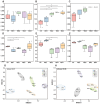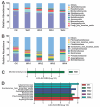Enhancing Morchella Mushroom Yield and Quality Through the Amendment of Soil Physicochemical Properties and Microbial Community with Wood Ash
- PMID: 39770609
- PMCID: PMC11676116
- DOI: 10.3390/microorganisms12122406
Enhancing Morchella Mushroom Yield and Quality Through the Amendment of Soil Physicochemical Properties and Microbial Community with Wood Ash
Abstract
Morchella mushroom is a nutritionally rich and rare edible fungus. The traditional cultivation model, which relies on expanding the cultivation area to meet market demand, is no longer sufficient to address the rapidly growing market demand. Enhancing the yield and quality of Morchella without increasing the cultivation area is an intractable challenge in the development of the Morchella mushroom industry. Against this backdrop, this study investigates the effects of different amounts of wood ash (WA) application on the yield and quality of Morchella, and conducts an in-depth analysis in conjunction with soil physicochemical properties and microbial communities. The results indicate that the application of WA improves both the yield and quality of Morchella, with the highest yield increase observed in the WA2 treatment (4000 kg/hm2), which showed a 118.36% increase compared to the control group (CK). The application of WA also modified the physicochemical properties of the soil, significantly improving the integrated fertility index of the soil (IFI, p < 0.05). The soil microbial community structure was altered by the addition of WA. Redundancy analysis (RDA) revealed that pH and total potassium (TK) were the main environmental factors influencing the bacterial community, while pH, TK, and total nitrogen (TN) were the main factors influencing the fungal community structure. In addition, bacterial community diversity tended to increase with higher WA application rates, whereas fungal community diversity generally showed a decreasing trend. Furthermore, the relative abundance of beneficial microbial communities, such as Acidobacteriota, which promote the growth of Morchella, increased with higher WA application, while the relative abundance of detrimental microbial communities, such as Xanthomonadaceae, decreased. Partial least squares path model (PLS-PM) analysis of external factors affecting Morchella yield and quality indicated that WA application can alter soil physicochemical properties and soil microbial communities, thereby improving Morchella yield and quality. Among these factors, soil fertility was identified as the most important determinant of Morchella yield and quality.
Keywords: Morchella yield; microbial community; soil fertility; wood ash.
Conflict of interest statement
The authors declare no conflicts of interest.
Figures









Similar articles
-
Microbial Community Response and Assembly Process of Yellow Sand Matrix in a Desert Marginal Zone Under Morchella Cultivation.Microorganisms. 2025 Apr 16;13(4):921. doi: 10.3390/microorganisms13040921. Microorganisms. 2025. PMID: 40284757 Free PMC article.
-
[Effects of Long-term Fertilization on Soil Microbial Diversity and Community Structure in the Agro-pastoral Ecotone].Huan Jing Ke Xue. 2023 Feb 8;44(2):1063-1073. doi: 10.13227/j.hjkx.202203143. Huan Jing Ke Xue. 2023. PMID: 36775629 Chinese.
-
[Effects of Different Microbial Fertilizers on Soil Quality and Maize Yield in Coastal Saline Soil].Huan Jing Ke Xue. 2024 Jul 8;45(7):4279-4292. doi: 10.13227/j.hjkx.202307148. Huan Jing Ke Xue. 2024. PMID: 39022973 Chinese.
-
Determination of the Effects of Pear-Morchella Intercropping Mode on M. sextelata Quality, Yield, and Soil Microbial Community.J Fungi (Basel). 2024 Nov 1;10(11):759. doi: 10.3390/jof10110759. J Fungi (Basel). 2024. PMID: 39590678 Free PMC article.
-
The Impact of Artificial Restoration of Alpine Grasslands in the Qilian Mountains on Vegetation, Soil Bacteria, and Soil Fungal Community Diversity.Microorganisms. 2024 Apr 25;12(5):854. doi: 10.3390/microorganisms12050854. Microorganisms. 2024. PMID: 38792684 Free PMC article. Review.
Cited by
-
Integrated Transcriptomics and Metabolomics Provide Insight into Degeneration-Related Molecular Mechanisms of Morchella importuna During Repeated Subculturing.J Fungi (Basel). 2025 May 30;11(6):420. doi: 10.3390/jof11060420. J Fungi (Basel). 2025. PMID: 40558932 Free PMC article.
-
Microbial Community Response and Assembly Process of Yellow Sand Matrix in a Desert Marginal Zone Under Morchella Cultivation.Microorganisms. 2025 Apr 16;13(4):921. doi: 10.3390/microorganisms13040921. Microorganisms. 2025. PMID: 40284757 Free PMC article.
References
-
- Wu F., Zhou L.W., Yang Z.L., Bau T., Li T.H., Dai Y.C. Resource diversity of Chinese macrofungi: Edible, medicinal and poisonous species. Fungal Divers. 2019;98:1–76. doi: 10.1007/s13225-019-00432-7. - DOI
Grants and funding
LinkOut - more resources
Full Text Sources
Research Materials
Miscellaneous

